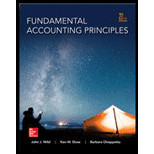
Journals:
Journals are the books where all the original entries of business transactions are recorded on basis of its occurrence order and date.
Sales Journal:
The journal where all the credit sales of merchandise are recorded is called a Sales Journal.
Cash Receipts Journal:
Cash receipts journal records all type cash receipts of a business organization like cash sales, collections from debtors, loans and borrowings etc.
A subsidiary ledger of accounts receivable shows the amount of money paid and owed by debtors for the transactions made on credit individually.
Schedule of Accounts Receivable:
A schedule of accounts receivable represents the overall amount of money owed by the debtors for credit transactions during a specified period.
To determine:
1. Preparation of sales journal and cash receipts journal. Journalize the transactions that should be recorded in the sales journal and cash receipts journal.
2. Prepare the general ledger accounts and accounts receivable subsidiary ledger accounts.
3. Verify the amounts that should be posted as individual amounts from the journals have been posted. Foot and crossfoot the journals and make the month-end postings.
4. Preparation of
5. Assume that the total for the schedule of accounts receivable does not equal the balance of the controlling account in the general ledger. Describe steps you would take to discover the error.
Want to see the full answer?
Check out a sample textbook solution
Chapter 7 Solutions
Fundamental Accounting Principles -Hardcover
- Please provide the answer to this general accounting question using the right approach.arrow_forwardA trial balance includes:A. Only revenue and expense accountsB. All accounts with balancesC. Only permanent accountsD. Only assets and liabilitiesarrow_forwardThe matching principle helps ensure:A. Revenues are equal to expensesB. Revenues and related expenses are recorded in the same periodC. Cash is matched to liabilitiesD. Accounts match physical inventoryneed helparrow_forward
- The matching principle helps ensure:A. Revenues are equal to expensesB. Revenues and related expenses are recorded in the same periodC. Cash is matched to liabilitiesD. Accounts match physical inventoryarrow_forwardCan you solve this general accounting problemarrow_forwardI need help ! A trial balance includes:A. Only revenue and expense accountsB. All accounts with balancesC. Only permanent accountsD. Only assets and liabilitiesarrow_forward
- Accounting question pleasearrow_forwardNo Ai A trial balance includes:A. Only revenue and expense accountsB. All accounts with balancesC. Only permanent accountsD. Only assets and liabilitiesarrow_forwardWhich account is increased with a credit?A. CashB. Salaries ExpenseC. Accounts ReceivableD. Service Revenue need helparrow_forward
- No AI A trial balance includes:A. Only revenue and expense accountsB. All accounts with balancesC. Only permanent accountsD. Only assets and liabilitiesarrow_forwardI need help with this general accounting problem using proper accounting guidelinesarrow_forwardHello Needed Answer of Financial Accounting Question with Correct Methodarrow_forward

 AccountingAccountingISBN:9781337272094Author:WARREN, Carl S., Reeve, James M., Duchac, Jonathan E.Publisher:Cengage Learning,
AccountingAccountingISBN:9781337272094Author:WARREN, Carl S., Reeve, James M., Duchac, Jonathan E.Publisher:Cengage Learning, Accounting Information SystemsAccountingISBN:9781337619202Author:Hall, James A.Publisher:Cengage Learning,
Accounting Information SystemsAccountingISBN:9781337619202Author:Hall, James A.Publisher:Cengage Learning, Horngren's Cost Accounting: A Managerial Emphasis...AccountingISBN:9780134475585Author:Srikant M. Datar, Madhav V. RajanPublisher:PEARSON
Horngren's Cost Accounting: A Managerial Emphasis...AccountingISBN:9780134475585Author:Srikant M. Datar, Madhav V. RajanPublisher:PEARSON Intermediate AccountingAccountingISBN:9781259722660Author:J. David Spiceland, Mark W. Nelson, Wayne M ThomasPublisher:McGraw-Hill Education
Intermediate AccountingAccountingISBN:9781259722660Author:J. David Spiceland, Mark W. Nelson, Wayne M ThomasPublisher:McGraw-Hill Education Financial and Managerial AccountingAccountingISBN:9781259726705Author:John J Wild, Ken W. Shaw, Barbara Chiappetta Fundamental Accounting PrinciplesPublisher:McGraw-Hill Education
Financial and Managerial AccountingAccountingISBN:9781259726705Author:John J Wild, Ken W. Shaw, Barbara Chiappetta Fundamental Accounting PrinciplesPublisher:McGraw-Hill Education





